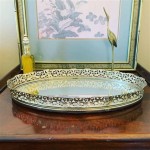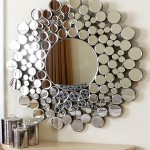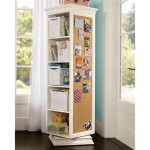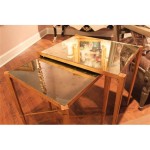How Far Should Bathroom Light Be Above Mirror
Proper bathroom lighting is crucial for both functionality and aesthetics. Incorrectly placed lighting can create shadows, making everyday tasks like shaving or applying makeup difficult. The distance between the bathroom light and the mirror plays a significant role in achieving optimal illumination.
Several factors influence the ideal height for bathroom lighting fixtures. These include the size of the mirror, the height of the ceiling, the type of light fixture, and the individual's height. A general guideline suggests placing the light fixture approximately 75 to 80 inches above the finished floor. This measurement typically places the light a few inches above the mirror, providing even illumination across the face and minimizing shadows.
The size of the mirror is an important consideration. For larger mirrors, extending beyond the standard width of a vanity, a longer light fixture or multiple fixtures may be necessary to ensure adequate lighting across the entire surface. With larger mirrors, the focus shifts from a single point of light to a broader, more distributed illumination. This approach prevents dark spots and provides consistent lighting for tasks requiring a wider field of view.
Ceiling height also affects the placement of bathroom lighting. In bathrooms with higher ceilings, the 75-80 inch guideline may need adjustment. Raising the fixture proportionally with the ceiling height maintains the proper relationship between the light source, the mirror, and the user. However, excessively high ceilings may require additional lighting elements, such as recessed lighting or sconces, to supplement the main fixture and eliminate shadows.
The type of light fixture significantly impacts the ideal mounting height. Different fixtures distribute light in varying patterns. Vanity lights, specifically designed for bathroom mirrors, often feature multiple bulbs and shades that direct light downwards. These fixtures are typically mounted directly above the mirror, with the bottom edge of the fixture a few inches above the top edge of the mirror. For other fixture types, such as pendants or chandeliers, the recommended height may vary based on their design and light distribution characteristics.
Individual height plays a role in determining the optimal lighting height. While the 75-80 inch guideline serves as a general rule, taller individuals may benefit from slightly higher placement. This prevents the fixture from obstructing their view in the mirror. Conversely, for shorter individuals, a slightly lower placement, while still adhering to the general guideline, may provide more effective illumination.
Beyond height, the type of light bulb used also affects the quality of bathroom lighting. LED bulbs are increasingly popular for their energy efficiency and long lifespan. They offer various color temperatures, measured in Kelvin (K). A color temperature between 3000K and 4000K is generally recommended for bathroom lighting. This range provides a neutral white light suitable for tasks requiring accurate color rendering, such as applying makeup.
The placement of wall sconces, if used in conjunction with overhead lighting, should also be carefully considered. Sconces are typically installed on either side of the mirror, at approximately eye level. This provides balanced illumination and minimizes shadows on the face. The specific height may need adjustment based on the individual's height and the size of the mirror.
Careful consideration of all these factors is essential for creating effective and aesthetically pleasing bathroom lighting. Achieving the correct balance between functionality and design enhances the overall bathroom experience. A well-lit bathroom is not only more practical but also contributes to a more comfortable and inviting atmosphere.
Consulting with a qualified electrician or lighting specialist can provide valuable insights and ensure the proper installation of bathroom lighting fixtures. They can assess the specific characteristics of the bathroom and recommend the optimal placement and type of lighting to meet individual needs and preferences. Professional guidance can also ensure compliance with building codes and electrical safety standards.
Experimentation can also be helpful in determining the ideal lighting height. Using temporary lighting solutions, such as adjustable lamps, can allow individuals to test different heights and observe the resulting light distribution before committing to a permanent installation. This allows for personalized adjustments based on individual preferences and the specific characteristics of the bathroom.
In addition to the height of the fixture, the direction of the light should also be considered. Ideally, the light should be directed downwards towards the mirror and the user's face. This minimizes shadows and provides even illumination. Some fixtures feature adjustable shades or heads, allowing for customization of the light direction.
Furthermore, the overall lighting design of the bathroom should be considered. While the mirror area requires specific attention, the general ambient lighting in the bathroom is also important. Recessed lighting, ceiling fixtures, or a combination of both can create a balanced and well-lit space. This ensures adequate visibility throughout the bathroom and complements the focused lighting around the mirror area.

How High To Place Your Bathroom Fixtures Inspired Style

How High To Place Your Bathroom Fixtures Inspired Style

Your Guide To Bathroom Lighting

How To Get Your Bathroom Vanity Lighting Right

Your Guide To Bathroom Lighting

How To Get Your Bathroom Vanity Lighting Right

How To Choose Bathroom Vanity Lighting Riverbend Home
:strip_icc()/101689996-61c812dfbcc045448f172bc7ab06922f.jpg?strip=all)
30 Bathroom Lighting Ideas For Every Decorating Style
How To Choose The Best Light For Above Your Medicine Cabinet Trubuild Construction

Ask A Designer How To Space Bathroom Mirror And Sconces Bathtubber








